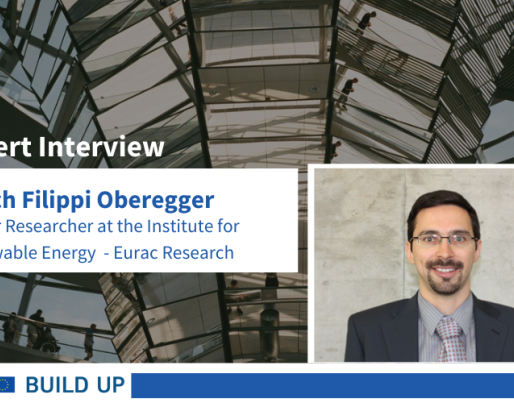Expert Interview - Ulrich Filippi Oberegger, Senior Researcher at the Institute for Renewable Energy (Eurac)

Expert Interview - Ulrich Filippi Oberegger, Senior Researcher at the Institute for Renewable Energy (Eurac)
The H2020 BuiltHub project - Dynamic EU building stock knowledge hub
Ulrich Filippi Oberegger is senior researcher in the Energy Efficient Buildings group at the Institute for Renewable Energy of Eurac Research. He is an innovator on data-driven methods and tools for building stock renovation strategies and human-building interaction improving the energy performance of buildings and the wellbeing of occupants. Ulrich holds a PhD degree in engineering sciences. He was collaborator in various European to regional R&D projects on sustainable and smart buildings and communities. Since October 2020, Ulrich is coordinating the H2020 four-year project BuiltHub.
1. The Dynamic EU Building Stock Knowledge Hub BuiltHub project aims at supporting with data and evidence policy and business decisions regarding the EU decarbonisation and energy efficiency targets. How is the project aiming to tackle this? What is the core strategy?
BuiltHub will deliver a roadmap for sustained data flow about the building stock in Europe to be fed into the next generation of the Building Stock Observatory (BSO), which is the tool endorsed by the European Commission to monitor and inform about the European building stock and its transition. BuiltHub’s core strategy is on the one hand to develop solutions that will allow stakeholders to overcome barriers in building data collection and sharing, and on the other hand to demonstrate services generating added value out of data. The ground truth will be provided by the consortium’s expertise, an analysis of existing data value chain approaches, the liaison with big data initiatives in the building sector, and the stakeholder community engaged throughout the project.
How this project intends to influence construction sector stakeholders and policymakers? How would approach and strategies differ?
One pillar for influencing the building sector is BuiltHub’s mission to create, engage, and sustain a vivid community of stakeholders who can express their needs and requirements, test the BuiltHub’s solutions, give feedback to fine-tune the solutions, and get in contact with each other to discuss and exchange thoughts. To reach this aim, multiple stakeholder engagement, dissemination, and communication actions are implemented. A second pillar is the contribution to the revision of EU directives and policies such as the EPBD (European Performance of Buildings Directive) and lobbying for increased data collection and sharing for the building sector. A third pillar is demonstrating the benefits of a data value chain providing insight. This demonstration will be performed through the BuiltHub platform.
To complete this introduction, can you present the project´s consortium and their main responsibilities?
We are eight partners. Eurac Research coordinates the project and works mainly on data assembly and quality control, platform services development, circular economy contributing to building stock decarbonization, data provision agreements, and the overall roadmap for data collection in the EU building stock sector. TU Wien contributes data analytics, data-to-knowledge transformation, data visualization and presentation, and quality testing of the BuiltHub concept and platform by pioneer users and an ambassador program. BPIE deals with stakeholder mapping, engagement, needs and requirements, community creation, and building stock progress monitoring. RISE works on data transformation and clustering empowered by machine learning techniques. They contribute to platform quality testing as well as building stock progress monitoring.
Everis, an NTT DATA company, provides the IT infrastructure and develops, engineers, reviews, deploys, and maintains the platform, from its architecture and internal components to the frontends. Sympraxis works on the business case for exploitation and sustainability, client-centric strategies for market uptake, and on data provision and marketing models. CARTIF will address data licensing and access issues and contribute to the data value chain from processing to presentation. ICLEI leads the communication and dissemination with a wide range of activities, from the overarching D&C plan, project identity and website, communication actions, media outreach, publications, and press activities to guidelines for enhancing the capacity of stakeholders and networking with related initiatives.
2. One of the main objectives of the project is to develop a roadmap for sustained data flow on the EU building stock. The roadmap shall be based on services providing stakeholders with insight on building stock features and performance. These services will be demonstrated by the BuiltHub platform. In particular, what type of data are you going to show and what methods will you use to collect and manage this data?
The basis for the offered services will be data about building characteristics, shell performances, technical systems, energy consumption, certification, financing, energy poverty, and the energy market. Less explored domains such as indoor environmental quality, electric vehicle readiness and smart readiness of buildings will be investigated as well. Data is being collected by identifying and tapping into data sources across Europe, such as Eurostat, JRC, national statistics institutes, energy agencies etc., outcomes from projects (e.g. HotMaps, TABULA, EPISCOPE, ZEBRA2020, ENTRANZE, ODYSSEE-MURE, CommONEnergy, SET-Nav, ExcEED, iNSPiRe), publications, strategies and action plans, e.g. the Long-Term Renovation Strategies (LTRS) and National Energy and Climate Plans (NECP), links with sister projects such as the big data projects BEYOND, BIGG, and MATRYCS, the BuiltHub community, and so on and so forth. The data will be centrally accessed, managed, and transformed into insight by the BuiltHub platform.
3. The project aims to bring together different actors to establish an active community. How will this be implemented? How communication and data sharing will be developed? and how would you deal with reliability and at the same time anonymisation of data and GDPR regulation?
The relevant stakeholders have been mapped and invited to join the BuiltHub community. A survey has been performed to identify their needs and requirements. Building on this basis, further engagement actions include expert interviews, workshops, strategic panels, webinars, stakeholder dialogues, one-on-one meetings, trainings, test loops with pioneer users of the BuiltHub platform to fine-tune the services, and an ambassador program. Dissemination and communication actions, networking with associated projects, participation in conferences and third-party meetings provide further occasions for growing the network.
A series of approaches are being explored to improve data sharing. Numerous barriers, such as data protection, the high effort to collect data, considering data as business-critical asset, uncertainty related to the added value of sharing data, lack of knowledge on how to capitalize on data, technical issues, intellectual property protection, licensing, missing metadata, and uncertainty about data quality prevent data sharing. Many of these barriers can be summarized as violation of the FAIR principle, which states that data shall be findable, accessible, interoperable, and re-usable. BuiltHub is developing strategies to overcome these barriers, such as data collaboratives, generation of synthetic data, aggregation or anonymization, and standardization of the data value chain.
4. Can you explain the novelty and complementarity of BuiltHub scope compared to, and interactions with, existing building databases, such as the European Construction Sector Observatory ECSO and other databases you mentioned before?
BuiltHub’s mission is two-fold: on the one hand, providing guidelines for sustained data flow about the European building stock, and on the other hand building a community of data providers and users. Therefore, BuiltHub’s mission is not creating a database but proposing pathways for data collection and sharing driven by the added value that data-based services can provide to stakeholders.
Existing projects and databases are an important step forward towards this goal and provide results BuiltHub can integrate. There are important differences with the data and insight BuiltHub is collecting and producing that make other initiatives and databases complementary and underline the importance and novelty of BuiltHub. For instance, the big data projects BEYOND, BIGG, and MATRYCS have a different scope and operate on a different level than BuiltHub. Data collection in these projects is typically at building systems or building level.
They focus on large-scale pilot studies and aim to innovate and demonstrate services concerning single buildings or building clusters. However, how to best extrapolate such detailed but isolated data to a larger area and context is a hot topic BuiltHub will contribute to. The ExcEED project was operating on a similar scale than the big data projects and provided useful ideas on, for example, key performance indicators. DEEP is one of the few open-source initiatives concentrating on energy efficiency investments and is thus being considered in BuiltHub as data source. Similarly, the ECSO represents an important data source about the European construction sector.
5. We will be following with great interest. What are the coming milestones and foreseen dissemination activities?
An important milestone in the upcoming months will be expert interviews to identify specific needs and datasets not known by the consortium. Experts will also give feedback about the relevance of datasets identified by the consortium. The so-formed expert team will represent key lead and end users and establish a communication between the consortium and these users.
Another main milestone will be the first operational prototype of the BuiltHub platform that will allow users to test the platform and its services and to provide feedback for enhancing the services. Concurrently with the first platform release, a stakeholder community webinar will be held presenting BuiltHub’s objectives, expected results and achievements. Furthermore, BuiltHub has applied, jointly with the big data projects BEYOND, BIGG and MATRYCS, to host an EUSEW policy session. This will be a great opportunity to discuss and disseminate the projects’ strategies with a wide audience.

